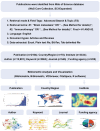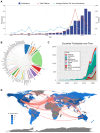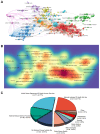Evolutionary Trend Analysis of Research on Immunotherapy for Brain Metastasis Based on Machine-Learning Scientometrics
- PMID: 39065701
- PMCID: PMC11280367
- DOI: 10.3390/ph17070850
Evolutionary Trend Analysis of Research on Immunotherapy for Brain Metastasis Based on Machine-Learning Scientometrics
Abstract
Brain metastases challenge cancer treatments with poor prognoses, despite ongoing advancements. Immunotherapy effectively alleviates advanced cancer, exhibiting immense potential to revolutionize brain metastasis management. To identify research priorities that optimize immunotherapies for brain metastases, 2164 related publications were analyzed. Scientometric visualization via R software, VOSviewer, and CiteSpace showed the interrelationships among literature, institutions, authors, and topic areas of focus. The publication rate and citations have grown exponentially over the past decade, with the US, China, and Germany as the major contributors. The University of Texas MD Anderson Cancer Center ranked highest in publications, while Memorial Sloan Kettering Cancer Center was most cited. Clusters of keywords revealed six hotspots: 'Immunology', 'Check Point Inhibitors', 'Lung Cancer', 'Immunotherapy', 'Melanoma', 'Breast Cancer', and 'Microenvironment'. Melanoma, the most studied primary tumor with brain metastases offers promising immunotherapy advancements with generalizability and adaptability to other cancers. Our results outline the holistic overview of immunotherapy research for brain metastases, which pinpoints the forefront in the field, and directs researchers toward critical inquiries for enhanced mechanistic insight and improved clinical outcomes. Moreover, governmental and funding agencies will benefit from assigning financial resources to entities and regions with the greatest potential for combating brain metastases through immunotherapy.
Keywords: bibliometric; brain metastases; cancer; immune checkpoint inhibitor; immunotherapy.
Conflict of interest statement
The authors declare no conflicts of interests.
Figures








Similar articles
-
A bibliometric and knowledge-map analysis of bispecific antibodies in cancer immunotherapy from 2000 to 2023.Heliyon. 2024 Jan 17;10(2):e23929. doi: 10.1016/j.heliyon.2023.e23929. eCollection 2024 Jan 30. Heliyon. 2024. PMID: 38312701 Free PMC article.
-
Advances and key focus areas in gastric cancer immunotherapy: A comprehensive scientometric and clinical trial review (1999-2023).World J Gastroenterol. 2023 Oct 28;29(40):5593-5617. doi: 10.3748/wjg.v29.i40.5593. World J Gastroenterol. 2023. PMID: 37970478 Free PMC article. Review.
-
Worldwide productivity and research trend of publications concerning tumor immune microenvironment (TIME): a bibliometric study.Eur J Med Res. 2023 Jul 10;28(1):229. doi: 10.1186/s40001-023-01195-3. Eur J Med Res. 2023. PMID: 37430294 Free PMC article.
-
Knowledge mapping of anaplastic thyroid cancer treatments: a bibliometric analysis (2000-2023).Front Oncol. 2024 Feb 14;14:1330030. doi: 10.3389/fonc.2024.1330030. eCollection 2024. Front Oncol. 2024. PMID: 38420016 Free PMC article.
-
Immunotherapy for ocular melanoma: a bibliometric and visualization analysis from 1991 to 2022.Front Oncol. 2023 May 31;13:1161759. doi: 10.3389/fonc.2023.1161759. eCollection 2023. Front Oncol. 2023. PMID: 37324010 Free PMC article.
Cited by
-
Predicting Survival Rates in Brain Metastases Patients from Non-Small Cell Lung Cancer Using Radiomic Signatures Associated with Tumor Immune Heterogeneity.Adv Sci (Weinh). 2025 Mar;12(10):e2412590. doi: 10.1002/advs.202412590. Epub 2025 Jan 22. Adv Sci (Weinh). 2025. PMID: 39840456 Free PMC article.
-
Metastatic brain tumors: from development to cutting-edge treatment.MedComm (2020). 2024 Dec 20;6(1):e70020. doi: 10.1002/mco2.70020. eCollection 2025 Jan. MedComm (2020). 2024. PMID: 39712454 Free PMC article. Review.
References
-
- Cagney D.N., Martin A.M., Catalano P.J., Redig A.J., Lin N.U., Lee E.Q., Wen P.Y., Dunn I.F., Bi W.L., Weiss S.E. Incidence and prognosis of patients with brain metastases at diagnosis of systemic malignancy: A population-based study. Neuro-Oncology. 2017;19:1511–1521. doi: 10.1093/neuonc/nox077. - DOI - PMC - PubMed
LinkOut - more resources
Full Text Sources
Miscellaneous

